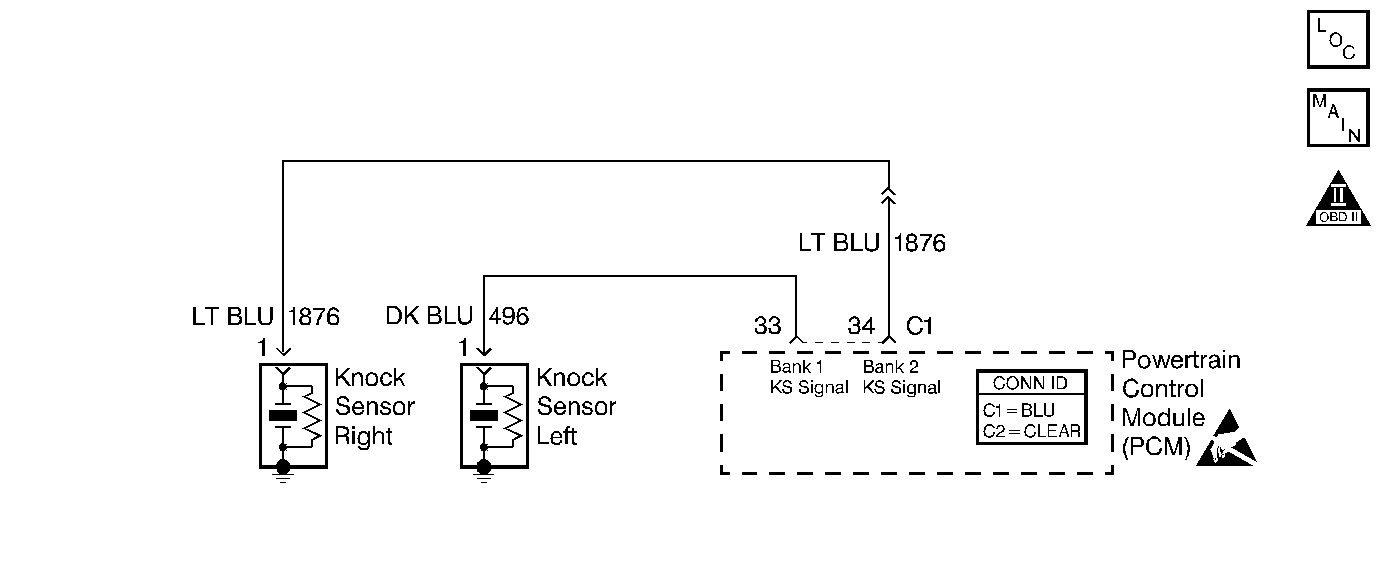
Circuit Description
The PCM contains integrated knock sensor (KS) diagnostic circuitry. The PCM uses the circuitry to diagnose the KS sensors and related wiring. The PCM calculates an average voltage of each knock sensors signals and takes instantaneous signal voltage readings. The PCM uses the instantaneous signal voltage readings to determine the state of the knock sensor circuitry. If the knock sensor system is operating normally, the PCM should monitor instantaneous KS signal voltage readings varying outside a voltage range is more than and less than the calculated average voltage. If the PCM malfunctions in a manner which will not allow proper diagnosis of the KS circuit DTC P0325 will set.
Conditions for Running the DTC
| • | No TP, VSS, CKP sensor, CMP sensor, MAF sensor, or ECT sensor DTCs are set. |
| • | Engine speed is between 1000 and 2500 RPM: |
| • | Throttle angle is more than 10 percent. |
| • | Engine load is more than 45 percent. |
| • | Engine coolant temperature is more than 60°C (140°F). |
| • | Maximum spark retard is less than 15 degrees. |
| • | System voltage is more than 9 volts. |
Conditions for Setting the DTC
| • | The PCM detects a malfunction in the integrated knock sensor diagnostic circuitry which will not allow proper diagnosis of the knock sensor circuits. |
| • | The condition is present for 300 3X reference periods (100 crankshaft revolutions). |
Action Taken When the DTC Sets
| • | The PCM will illuminate the malfunction indicator lamp (MIL) during the second consecutive trip in which the diagnostic test has been run and failed. |
| • | The PCM will store conditions which were present when the DTC set as Freeze Frame/Failure Records data. |
Conditions for Clearing the MIL/DTC
| • | The PCM will turn OFF the malfunction indicator lamp (MIL) during the third consecutive trip in which the diagnostic has run and passed. |
| • | The history DTC will clear after 40 consecutive warm-up cycles have occurred without a malfunction. |
| • | The DTC can be cleared by using a scan tool. |
Diagnostic Aids
Inspect for the following:
Many situations may lead to an intermittent condition. Perform each inspection or test as directed.
Important: : Remove any debris from the connector surfaces before servicing a component. Inspect the connector gaskets when diagnosing or replacing a component. Ensure that the gaskets are installed correctly. The gaskets prevent contaminate intrusion.
| • | Loose terminal connection |
| - | Use a corresponding mating terminal to test for proper tension. Refer to Testing for Intermittent Conditions and Poor Connections , and to Connector Repairs in Wiring Systems for diagnosis and repair. |
| - | Inspect the harness connectors for backed out terminals, improper mating, broken locks, improperly formed or damaged terminals, and faulty terminal to wire connection. Refer to Testing for Intermittent Conditions and Poor Connections , and to Connector Repairs in Wiring Systems for diagnosis and repair. |
| • | Damaged harness--Inspect the wiring harness for damage. If the harness inspection does not reveal a problem, observe the display on the scan tool while moving connectors and wiring harnesses related to the sensor. A change in the scan tool display may indicate the location of the fault. Refer to Wiring Repairs in Wiring Systems for diagnosis and repair. |
| • | Inspect the powertrain control module (PCM) and the engine grounds for clean and secure connections. Refer to Wiring Repairs in Wiring Systems for diagnosis and repair. |
If the condition is determined to be intermittent, reviewing the Snapshot or Freeze Frame/Failure Records may be useful in determining when the DTC or condition was identified.
Test Description
The numbers below refer to the step numbers on the diagnostic table.
-
Ensures that the malfunction is present.
-
This vehicle is equipped with a PCM which utilizes an Electrically Erasable Programmable Read Only Memory (EEPROM). When the PCM is replaced, the new PCM must be programmed.
Step | Action | Values | Yes | No |
|---|---|---|---|---|
1 | Did you perform the Powertrain On-Board Diagnostic (OBD) System Check? | -- | ||
|
Important:: If an engine knock can be heard repair the engine mechanical problem before proceeding with this diagnostic. Refer to Engine Noise Diagnosis in Engine Mechanical.
Does scan tool indicate this DTC failed this ignition? | -- | |||
3 |
Does the scan tool indicate this DTC failed this ignition? | -- | Go to Diagnostic Aids | |
|
Important:: The replacement PCM must be programmed. Replace the PCM. Refer to Powertrain Control Module Replacement/Programming . Did you complete the replacement? | -- | -- | ||
5 |
Does the DTC reset? | -- | System OK |
